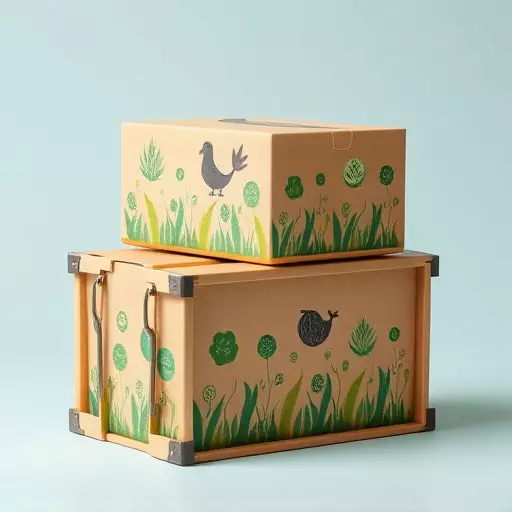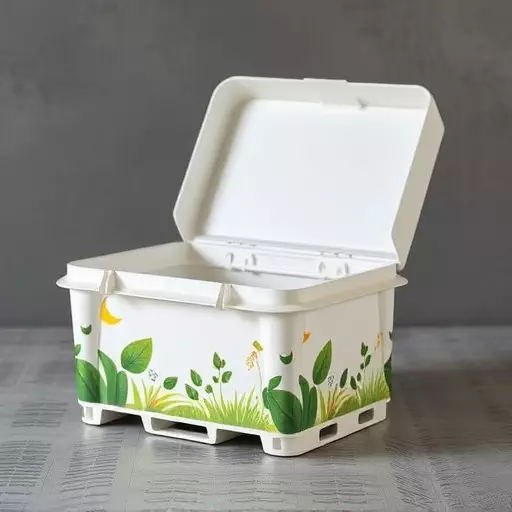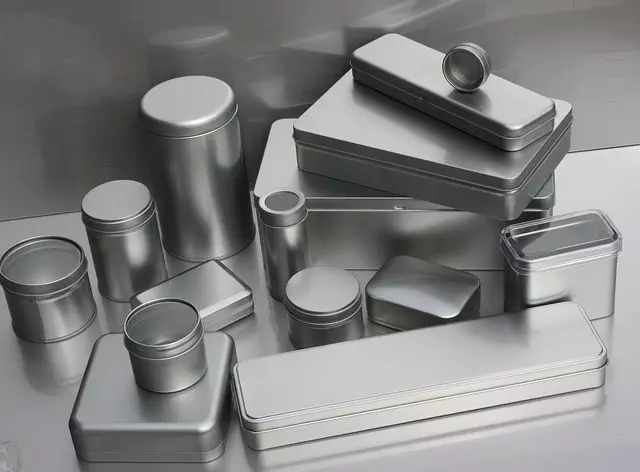TL;DR:
Adopting recyclable and custom container packaging solutions is a key step towards environmental sustainability, driven by growing concerns about waste management and climate change. Businesses are demanding eco-friendly options, leading to the use of recycled or biodegradable materials like cornstarch plastics and mushroom bioplastics. Custom container packaging allows tailored designs that minimize waste and reduce carbon footprints, contributing to a circular economy. This trend features minimalist designs and innovative materials, making sustainable packaging the new industry standard.
Implementing effective recycling programs involves assessing current systems, setting objectives, partnering with experts, designing easier-to-recycle packaging, educating users, establishing collection systems, processing collected materials, and marketing them for continued use.
The future of container packaging is green, with an emphasis on biodegradable plastics, plant-based resins, recycled content, and custom designs that reduce waste. Companies must adapt to these trends to meet the demands of a more sustainable future.
“Container packaging has evolved into a vital component of environmental sustainability, with a focus on recyclable and eco-friendly solutions. This article explores the comprehensive world of container packaging, from its environmental impact to innovative materials and design strategies. We delve into the global shift towards sustainable container packaging, highlighting the benefits for businesses through custom designs. Additionally, we provide a step-by-step guide to implementing recycling programs and forecast future trends, emphasizing the potential for a greener tomorrow through advanced container packaging solutions.”
- Understanding Recyclable Container Packaging: A Key to Environmental Sustainability
- The Rise of Sustainable Container Packaging: A Global Shift
- Benefits of Custom Container Packaging for Businesses
- Material Innovations in Container Packaging: Eco-Friendly Alternatives
- Design Considerations for Effective Recyclable Packaging
- Implementing Recycling Programs: A Step-by-Step Guide
- Future Trends in Container Packaging Solutions: Predicting a Greener Tomorrow
Understanding Recyclable Container Packaging: A Key to Environmental Sustainability

Understanding recyclable container packaging is a crucial step towards achieving environmental sustainability. In today’s world, where concerns about waste management and climate change are on the rise, adopting eco-friendly container packaging solutions has become not just a choice but a necessity. Businesses and consumers alike are realizing the impact of their packaging decisions, leading to a growing demand for sustainable container packaging options.
Custom container packaging plays a pivotal role in this transition. By allowing manufacturers to design packaging tailored to specific product needs, it ensures efficiency and minimal waste generation. These custom solutions can be made from recycled materials or biodegradable sources, reducing the carbon footprint associated with traditional packaging methods. Embracing recyclable container packaging not only contributes to preserving natural resources but also fosters a circular economy where waste is minimized, and resources are continually reused.
The Rise of Sustainable Container Packaging: A Global Shift

The global shift towards sustainability has significantly impacted the way we approach container packaging. Increasing awareness about environmental issues and the growing demand for eco-friendly solutions have led to a surge in the adoption of sustainable container packaging. Businesses are now actively seeking out innovative container packaging solutions that minimize waste, reduce carbon footprints, and contribute to a circular economy. Custom container packaging plays a pivotal role in this transformation, enabling companies to create tailored designs that meet specific product requirements while adhering to sustainability standards.
This shift is evident in the rising popularity of biodegradable materials, such as cornstarch-based plastics and recycled fiber, which are being incorporated into various container packaging types. Furthermore, the trend towards minimalism and sleek designs not only appeals to consumers but also streamlines logistics and reduces material usage. As a result, sustainable container packaging is fast becoming the norm across industries, driving a global movement towards more responsible and environmentally conscious practices in packaging design and production.
Benefits of Custom Container Packaging for Businesses

Material Innovations in Container Packaging: Eco-Friendly Alternatives

The evolution of container packaging has seen a significant shift towards eco-friendly alternatives, driven by the need to reduce environmental impact and embrace sustainability. Material innovations play a pivotal role in this transformation, offering more sustainable container packaging solutions that can meet the diverse needs of modern businesses while minimising waste. Biodegradable materials like plant-based plastics, mushroom-derived bioplastics, and recycled fibres are gaining traction as viable replacements for traditional petroleum-based polymers. These advanced materials not only break down naturally but also often require less energy to produce, contributing to a lower carbon footprint throughout the packaging supply chain.
Custom container packaging is another area where sustainability is being integrated. Customisation allows brands to design packages tailored to their products’ specific requirements while incorporating eco-friendly elements. This might include using minimal packaging, adopting recyclable or compostable materials, and optimising package shapes for efficient transportation and storage. Such innovations not only reduce the environmental impact of container packaging but also enhance brand image and consumer perception, as increasingly conscious consumers seek out sustainable product choices.
Design Considerations for Effective Recyclable Packaging

Implementing Recycling Programs: A Step-by-Step Guide

Implementing Recycling Programs is a multi-step process that can significantly contribute to sustainability goals and reduce environmental impact, especially in the realm of container packaging solutions. Here’s a step-by-step guide to get started:
1. Assess Current Practices: Begin by evaluating your current container packaging system. Identify types of materials used, disposal methods, and existing recycling programs (if any). Understanding these will help tailor new initiatives effectively.
2. Define Objectives: Set clear goals for your recycling program. This could include reducing waste sent to landfills, increasing recycled content in packaging, or achieving a certain percentage of overall packaging sustainability. Specific objectives guide the entire process.
3. Partner with Recycling Experts: Collaborate with companies specializing in recycling and sustainable container packaging. They can provide valuable insights, equipment, and expertise, ensuring your program is optimized from collection to processing.
4. Design Custom Container Packaging: Encourage the design of custom container packaging that facilitates recycling. This might involve using easily recyclable materials, improving product shapes for efficient sorting, or incorporating clear labeling to guide consumers.
5. Educate Employees and Customers: Launch awareness campaigns to educate both employees and customers about the importance of recycling and how they can participate. Clear communication ensures everyone understands their role in the process.
6. Implement Collection Systems: Set up collection points within your facilities and explore options for curbside or community recycling programs. Efficient collection systems ensure a steady flow of recyclable materials.
7. Process and Market Recycled Materials: Work with recyclers to process collected materials into new products or raw materials. Additionally, market these recycled materials to create a demand that reinforces sustainable practices.
Future Trends in Container Packaging Solutions: Predicting a Greener Tomorrow

The future of container packaging is bright and green, as businesses increasingly embrace sustainability and environmental responsibility. One prominent trend in container packaging solutions is the shift towards eco-friendly materials. Innovations such as biodegradable plastics, plant-based resins, and recycled content are gaining traction, offering viable alternatives to traditional petroleum-based polymers. These materials not only reduce carbon footprints but also contribute to a circular economy, where resources are reused and repurposed.
Custom container packaging is another growing area of interest. Brands are designing unique, specialized packaging that caters to specific product needs while minimizing waste. This involves innovative shapes, sizes, and materials, often combined with advanced printing techniques to enhance branding and consumer engagement. As consumers become more conscious of sustainable container packaging, companies that adapt to these trends will be well-positioned to meet the demands of a greener tomorrow.


